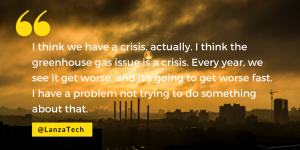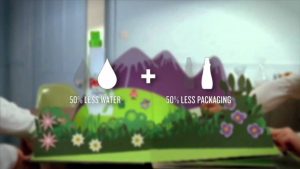Together, the world is under a huge transition: we are facing an economical, social and  ecological changeover. For a sustainable progress the business world shares common concerns in terms of rising energy costs, water shortages, food shortage, education, energy conservation, carbon emissions, waste management etc, etc. The business world is closely working on ecological economics which is also called bio-economics. Bio-economics is an interdisciplinary field which addresses the interdependence of human economies with natural ecosystem. By treating the economy as a subsystem of Earth’s larger ecosystem, and by emphasizing the preservation of natural capital the business world is awakened to the fact that their sustainability is closely related to environmental sustainability.
ecological changeover. For a sustainable progress the business world shares common concerns in terms of rising energy costs, water shortages, food shortage, education, energy conservation, carbon emissions, waste management etc, etc. The business world is closely working on ecological economics which is also called bio-economics. Bio-economics is an interdisciplinary field which addresses the interdependence of human economies with natural ecosystem. By treating the economy as a subsystem of Earth’s larger ecosystem, and by emphasizing the preservation of natural capital the business world is awakened to the fact that their sustainability is closely related to environmental sustainability.
The business world needs to cope with the rapidly changing sustainability landscape while balancing their financial performance and growing costs of energy and raw materials. The sustainability performance question spans diversely with academic disciplines such as human resource management, marketing, economics, accounting, tourism, operations, law, governance, supply chain and many more. Although handling a fusion of these diverse disciplines is a tough job, yet, being realistic is most important for survival of the planet.
For many of us, the meaning of sustainability remains elusive. Some equate it to environmental wellbeing while others think of sustainability as equivalent to corporate social responsibility. Let us understand this: business sustainability refers to the ability of firms to respond to their short term as well as long term performance needs without compromising on their future growth that requires the natural and human resources available in the external environment. One more fact is that the balancing of economic, social, and ecology is fragile in nature. Therefore, sustainability encompasses voluntary corporate strategies geared towards an integration of environmental, social, and economic objectives into the fabric of the organisational life (Quinn & Dalton, 2009). Let’s look at some brilliant examples of how companies are innovating.
The world’s largest shipping companies such as DHL, UPS & FedEx need to bear tons of maintenance fees for the maintenance of their vehicles, as well as the costs of oil and gasoline to keep them running. As an alternative to that, and also to cut through busy and crowded streets, each of the companies has been innovated various new delivery methods. DHL has set up couriers on bicycles in nine European countries so far, including its most recent entry in a few German cities. The company replaced 33 trucks with 33 cargo bikes in the Netherlands, which DHL estimates saves them $575,000 annually and reduces carbon dioxide emissions by 152 metric tons per year. The company knew customers were asking for a “cleaner transport alternative” to the gas-guzzling trucks, and the bikes as part of clean environment solution. The efforts of DHL are highly appreciable for it aims to utilize bicycle couriers in the next few years anywhere in the world to improve their customer service and effectiveness.
Cargo bikes are also taking various forms for FedEx and UPS — each of course with the company’s standard logos and colour schemes. FedEx began piloting electric tricycles in Paris as early as 2010, and UPS expanded its use of electric Cargo Cruisers since 2012 in several European cities. Other businesses like Whole Foods and Ikea are also experimenting with delivery through bicycles.
LanzaTech is a clean-tech company that’s revolutionizing the way the world thinks about carbon waste. The company uses a bacterium for its fermentation, Clostridium autoethanogenum, which eats carbon monoxide and emits ethanol without using water or land resources. The company treats carbon as an opportunity instead of a liability. LanzaTech’s proprietary microbes capture and recycle waste gases before they are emitted as greenhouse gases, reducing harmful nitrous and sulphur oxides by over 85%. Essentially, they’re turning air into something of value. The company estimates it can apply its process to 65% of the world’s steel mills, with the potential to make 30 billion gallons of ethanol, or 19% of today’s current jet fuel demand. Kudos to this company!!!
Google’s Nest: uses a system that turns food waste into compost or that a shipping company is doing what it can to cut down on emissions, there are also companies providing you with direct ways to impact the environment yourself. One of those is Nest, the smart thermostat system that was acquired by Google in 2014. According to Nest, half of your energy bill is affected by your thermostat alone. The company estimates that by using a programmable thermostat that automatically adjusts for sleeping, when you’re awake, and other learned routines, the system can decrease by about 20%.
In India, Jain Irrigation Systems Ltd is a diversified entity with turnover in excess of one billion dollars. The company has a global presence with 30 manufacturing bases spread over four continents. Through its 6700 dealers and distributors worldwide, the company has reached over 4.5 million farmers. This is world’s second largest Micro-Irrigation company. Its Micro-Irrigation Division manufactures a full range of precision-irrigation products. Jain irrigation provides services from soil survey, engineering design to agronomic support. It nurtures a sprawling 2000 acre Hi-Tech Agri Institute including a Farm Resource R&D, Demo, and Training & Extension Centre. It also undertakes turnkey projects for agricultural and irrigation development with holistic & integrated approach. Over 1500 agri and irrigation scientists, engineers and technicians are engaged in offering services for complete or partial project planning and implementation e.g Watershed Development through Wasteland Transformation, including crop agronomy, protected cultivation etc.
Their Tissue Culture Division can produce 80 million plantlets of banana at full capacity and has established matching primary and secondary hardening facilities as well as independent R&D and virology labs. Similarly, a modern Bio- tech lab equipped with all modern and state–of–the–art facilities meet the needs of continuous genetic improvement and validation program in cultivators of onion, banana, mango, pomegranate etc. They process tropical fruits like mango, banana, and pomegranates into purees, concentrates, juices and IQF products. The Dehydration Facility dehydrates onions & vegetables. The Spray Drying Unit processes gooseberry and other fruit purees into powders. The best part is that agricultural and fruit processing waste is converted into biogas to generate power of 1.6 MW capacities along with waste heat for refrigeration and soil conditioner.
Unilever’s Sustainable Living Plan: Unilever in 2010 launched its blueprint for sustainable business, named the Unilever Sustainable Living Plan. Sustainable living brands, including Dove, Lifebuoy, Ben & Jerry’s and Comfort are integrated into the contribution they make to the world and into their products’ ingredients and lifecycle. The consumer goods giant says about 50 percent of its growth in 2014 came from sustainable living brands, which also grew at twice the rate of the rest of the business. Not only are Unilever’s sustainable living products more profitable than standard products by 2 gross margin points, these products also drive other top-line benefits, Unilever says. This purposefulness and sustainable living plan attracts and retains young talent. No wonder, Unilever is among top 3 most sought-after employers globally. About 50 percent of graduates cite Unilever sustainability credentials as the main reason for wishing to join the company.
GE Ecomagination: GE’s Ecoimagination line of products and services has generated more than $200 billion in revenues since GE started the program 10 years ago. Revenue from Ecomagination products totalled $34 billion in 2014, representing about 30 percent of total GE sales. A key success factor for Ecomagination is to reduce energy and water waste in manufacturing, Intel Corp works with GE to develop advanced manufacturing and digital optimization techniques to increase resource productivity in manufacturing.
Ikea Sustainable Home Products: This Company contributes to a more sustainable life at home for consumers. Its entire lighting range is now LED. It plans to become resource and energy independent which means helping to replace the industry with key raw materials like cotton and wood, investing in renewable energy and becoming more efficient in operations and supply chain. Ikea wants to make every product more sustainable while keeping the quality, function, form and affordability for their customers.
Conclusion: The environmental aspect of sustainability considers the impact of organisational activities on natural resource depletion, pollution and emission management, waste management, and energy and resource use among others. The social aspect of sustainability reflects on the social obligation of the organisation to the communities by managing issues such as poverty, income inequality, disease, access to health care, clean water, sanitation, education and broader societal problems that organisations are increasingly called upon to solve. Finally, the economic aspect of sustainability concerns the viability of the organisation to financially thrive in a competitive marketplace by balancing both environment and society.
















































